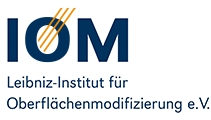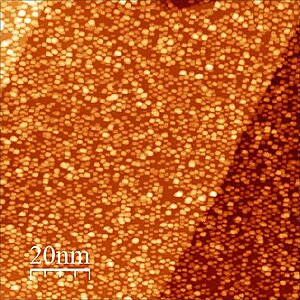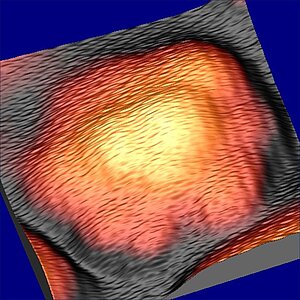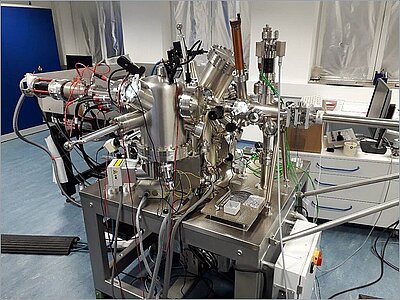Rastersondenmikroskopie an Einzelmolekülen und Molekularschichten
Die stetige Miniaturisierung von elektronischen Bauteilen in der Halbleitertechnik lässt die Entwicklung von molekularen Schaltern auf funktionalen Oberflächen zunehmend an Bedeutung gewinnen. Durch die Integration von molekularen Oxiden lässt sich die Kapazität und Energieeffizienz klassischer Speichermedien um ein Vielfaches erhöhen und gleichzeitig auch die Entwicklung neuartiger neuromorpher Systeme vorantreiben.
Die kontrollierte Abscheidung von Einzelmolekülen und darauf basierenden Dünnschichten auf Oberflächen stellt neben deren Kontaktierung traditionell eine der größten Herausforderungen auf dem Gebiet der Molekularelektronik dar. Wir verwenden hierfür verschiedene Depositionsmethoden wie klassisches Dip-/Drop-Coating sowie weiterentwickelte Techniken wie Spin-Coating und Elektrospray-Verfahren zur gezielten Adsorption auf einfachen und strukturierten Oberflächen. Besonderes Augenmerk liegt dabei auf den komplexen intermolekularen Wechselwirkungen in der flüssigen Phase und deren Auswirkungen auf die Adsorptionseigenschaften.
Die Rastersondenmikroskopie unter Ultrahochvakuum-Bedingungen mit Auflösungen im (sub)molekularen Bereich als primäre Untersuchungstechnik liefert entscheidende Einblicke in deren strukturelle und elektronische Eigenschaften. Die Messspitze fungiert hierbei neben ihrer bildgebenden Eigenschaft auch als „Nanoelektrode“ zur Kontaktierung und Manipulation der molekularen Systeme.
Expertise
- Präparation komplexer Oberflächensysteme
- Ultrahochvakuumtechnik und Oberflächenanalytik
- Rastertunnelmikroskopie (STM) und –spektroskopie (STS)
- Leitfähigkeits-Rasterkraftmikroskopie (LC-AFM)
- Elektronische und strukturelle Manipulation von Einzelmolekülen und Dünnschichten
Highlights
Insights from Adsorption and Electron Modification Studies of Polyoxometalates on Surfaces for Molecular Memory Applications

M. Moors, J. Warneke, X. López, C. de Graaf, B. Abel, K. Y. Monakhov
Acc. Chem. Res. 2021, 54, 3377–3389
https://pubs.acs.org/doi/10.1021/acs.accounts.1c00311This Account highlights recent experimental and theoretical work focusing on the development of polyoxometalates (POMs) as possible active switching units in what may be called “molecule-based memory cells”. Herein, we critically discuss how multiply charged vanadium-containing POMs, which exhibit stable metal–oxo bonds and are characterized by the excellent ability to change their redox states without significant structural distortions of the central polyoxoanion core, can be immobilized best and how they may work optimally at appropriate surfaces. Furthermore, we critically discuss important issues and challenges on the long way toward POM-based nanoelectronics. This Account is divided into four sections shedding light on POM interplay in solution and on surfaces, ion soft-landing of mass-selected POMs on surfaces, electronic modification of POMs on surfaces, and computational modeling of POMs on surfaces. The sections showcase the complex nature of far-reaching POM interactions with the chemical surroundings in solution and the properties of POMs in the macroscopic environment of electrode surfaces. Section 2 describes complex relationships of POMs with their counter-cations, solvent molecules, and water impurities, which have been shown to exhibit a direct impact on the resulting surface morphology, where a concentration-dependent formation of micellar structures can be potentially observed. Section 3 gives insights into the ion soft-landing deposition of mass-selected POMs on electrode surfaces, which emerges as an appealing method because the simultaneous deposition of agglomeration-stimulating counter-cations can be avoided. Section 4 provides details of electronic properties of POMs and their modification by external electronic stimuli toward the development of multiple-state resistive (memristive) switches. Section 5 sheds light on issues of the determination of the electronic structure properties of POMs across their interfaces, which is difficult to address by experiment. The studies summarized in these four sections have employed various X-ray-scattering, microscopy, spectroscopy, and computational techniques for imaging of POM interfaces in solution and on surfaces to determine the adsorption type, agglomeration tendency, distribution, and oxidation state of deposited molecules. The presented research findings and conceptual ideas may assist experimentalists and theoreticians to advance the exploration of POM electrical conductivity as a function of metal redox and spin states and to pave the way for a realization of (“brain-inspired”) POM-based memory devices, memristive POM-surface device engineering, and energy efficient nonvolatile data storage and processing technologies.
TiOx/Pt3Ti(111) surface-directed formation of electronically responsive supramolecular assemblies of tungsten oxide clusters
M. Moors, Y. An, A. Kuc, K. Y. Monakhov
Beilstein J. Nanotechnol. 2021, 12, 203–212
https://www.beilstein-journals.org/bjnano/articles/12/16Highly ordered titanium oxide films grown on a Pt3Ti(111) alloy surface were utilized for the controlled immobilization and tip-induced electric field-triggered electronic manipulation of nanoscopic W3O9 clusters. Depending on the operating conditions, two different stable oxide phases, z’-TiOx and w’-TiOx, were produced. These phases show a strong effect on the adsorption characteristics and reactivity of W3O9 clusters, which are formed as a result of thermal evaporation of WO3 powder on the complex TiOx/Pt3Ti(111) surfaces under ultra-high vacuum conditions. The physisorbed tritungsten nano-oxides were found as isolated single units located on the metallic attraction points or as supramolecular self-assemblies with a W3O9-capped hexagonal scaffold of W3O9 units. By applying scanning tunneling microscopy to the W3O9–(W3O9)6 structures, individual units underwent a tip-induced reduction to W3O8. At elevated temperatures, agglomeration and growth of large WO3 islands, which thickness is strongly limited to a maximum of two unit cells, were observed. The findings boost progress toward template-directed nucleation, growth, networking, and charge state manipulation of functional molecular nanostructures on surfaces using operando techniques.
Interplaying the amphipathic polyoxometalate interactions in solution and at solid–liquid interfaces: A toolbox for the technical application
M. Glöß, R. Pütt, M. Moors, E. Kentzinger, W. Pyckhout-Hintzen, K. Y. Monakhov
Nanoscale 2019, 11, 4267–4277
https://doi.org/10.1039/C8NR08008AThe far-reaching interplay between the speciation of polyoxometalates (POMs) in the liquid phase and the POM adsorption characteristics on substrate surfaces yet remains to be understood. The significance of this interplay is however paramount because it indicates the degree of technical applicability of solvent-processable POM molecules. Herein, we target this fundamentally important issue, shedding light on the “POM–counterion–solvent” and “POM–counterion–solvent–substrate” processes. We effectively combine the results from small-angle X-ray scattering in solution with surface sensitive scanning tunneling microscopy and X-ray photoelectron spectroscopy measurements and present on this basis a semi-quantitative analysis which provides an excellent correlation between both approaches. The MeCN-solution speciation of a tris(alkoxo)-ligated Wells–Dawson-type polyoxoanion – explored as a representative of commonly negatively charged POM-based inorganic–organic nanostructures – is strikingly connected with the growth of porous two-dimensional molecular layers on highly oriented pyrolytic graphite (HOPG). Low water amounts dramatically transform intermolecular relationships toward hierarchical agglomeration that inhibits the layer formation on HOPG. The obtained findings lay the groundwork for a mechanistic study of controlled nucleation and growth of POM nanostructures on weakly interacting surfaces.
Addressing multiple resistive states of polyoxovanadates: Conductivity as a function of individual molecular redox states
O. Linnenberg, M. Moors, A. Notario-Estévez, X. López, C. de Graaf, S. Peter, C. Bäumer, R. Waser, K. Y. Monakhov
J. Am. Chem. Soc. 2018, 140, 16635–16640
https://doi.org/10.1021/jacs.8b08780The sustainable development of IT-systems requires a quest for novel concepts to address further miniaturization, performance improvement, and energy efficiency of devices. The realization of these goals cannot be achieved without an appropriate functional material. Herein, we target the technologically important electron modification using single polyoxometalate (POM) molecules envisaged as smart successors of materials that are implemented in today’s complementary metal-oxide-semiconductor (CMOS) technology. Lindqvist-type POMs were physisorbed on the Au(111) surface, preserving their structural and electronic characteristics. By applying an external voltage at room temperature, the valence state of the single POM molecule could be changed multiple times through the injection of up to 4 electrons. The molecular electrical conductivity is dependent on the number of vanadium 3d electrons, resulting in several discrete conduction states with increasing conductivity. This fundamentally important finding illustrates the far-reaching opportunities for POM molecules in the area of multiple-state resistive (memristive) switching.
Resistive Switching Mechanisms on TaOx and SrRuO3 Thin-Film Surfaces Probed by Scanning Tunneling Microscopy
M. Moors, K. K. Adepalli, Q. Lu, A. Wedig, C. Bäumer, K. Skaja, B. Arndt, H. L. Tuller, R. Dittmann, R. Waser, B. Yildiz, I. Volov
ACS Nano 2016, 10, 1481–1492
https://doi.org/10.1021/acsnano.5b07020The local electronic properties of tantalum oxide (TaOx, 2 ≤ x ≤ 2.5) and strontium ruthenate (SrRuO3) thin-film surfaces were studied under the influence of electric fields induced by a scanning tunneling microscope (STM) tip. The switching between different redox states in both oxides is achieved without the need for physical electrical contact by controlling the magnitude and polarity of the applied voltage between the STM tip and the sample surface. We demonstrate for TaOx films that two switching mechanisms operate. Reduced tantalum oxide shows resistive switching due to the formation of metallic Ta, but partial oxidation of the samples changes the switching mechanism to one mediated mainly by oxygen vacancies. For SrRuO3, we found that the switching mechanism depends on the polarity of the applied voltage and involves formation, annihilation, and migration of oxygen vacancies. Although TaOx and SrRuO3 differ significantly in their electronic and structural properties, the resistive switching mechanisms could be elaborated based on STM measurements, proving the general capability of this method for studying resistive switching phenomena in different classes of transition metal oxides.



